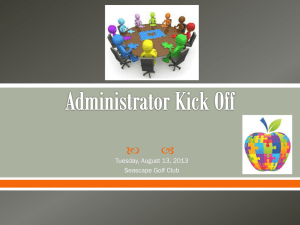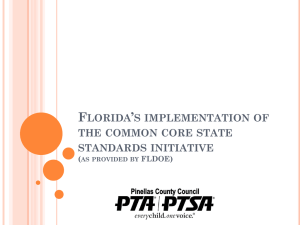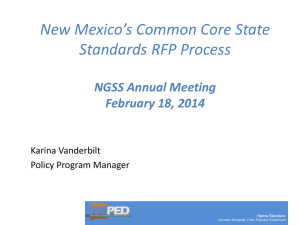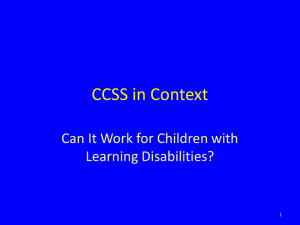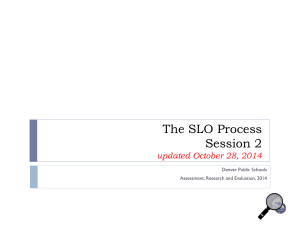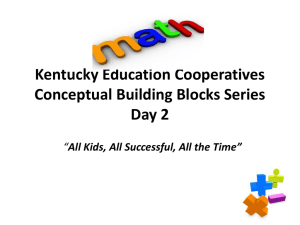word problems
advertisement
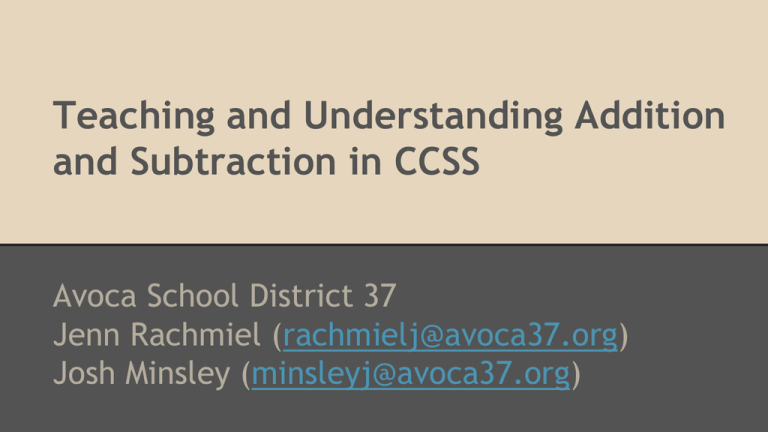
Teaching and Understanding Addition and Subtraction in CCSS Avoca School District 37 Jenn Rachmiel (rachmielj@avoca37.org) Josh Minsley (minsleyj@avoca37.org) Goals for Today 1. Where are the word problems in CCSS? 2. Explore the progression of addition and subtraction in grades k - 5. 3. Make sense of the structure of word problems. 4. Connect word problems with algebraic equations. 5. Explore the use of context in daily lessons. Where are Word Problems in the standards? Kindergarten CCSS.Math.Content.K.OA.A.2 Solve addition and subtraction word problems, and add and subtract within 10, e.g., by using objects or drawings to represent the problem. First Grade CCSS.Math.Content.1.OA.A.1 Use addition and subtraction within 20 to solve word problems involving situations of adding to, taking from, putting together, taking apart, and comparing, with unknowns in all positions, e.g., by using objects, drawings, and equations with a symbol for the unknown number to represent the problem. Where are Word Problems in the standards? Second Grade CCSS.Math.Content.2.OA.A.1 Use addition and subtraction within 100 to solve one- and two-step word problems involving situations of adding to, taking from, putting together, taking apart, and comparing, with unknowns in all positions, e.g., by using drawings and equations with a symbol for the unknown number to represent the problem. CCSS.Math.Content.2.MD.B.5 Use addition and subtraction within 100 to solve word problems involving lengths that are given in the same units, e.g., by using drawings (such as drawings of rulers) and equations with a symbol for the unknown number to represent the problem. CCSS.Math.Content.2.MD.C.8 Solve word problems involving dollar bills, quarters, dimes, nickels, and pennies, using $ and ¢ symbols appropriately. Where are Word Problems in the standards? Third Grade CCSS.Math.Content.3.OA.A.3 Use multiplication and division within 100 to solve word problems in situations involving equal groups, arrays, and measurement quantities, e.g., by using drawings and equations with a symbol for the unknown number to represent the problem. CCSS.Math.Content.3.OA.D.8 Solve two-step word problems using the four operations. Represent these problems using equations with a letter standing for the unknown quantity. Assess the reasonableness of answers using mental computation and estimation strategies including rounding. Where are Word Problems in the standards? Fourth Grade CCSS.Math.Content.4.OA.A.2 Multiply or divide to solve word problems involving multiplicative comparison, e.g., by using drawings and equations with a symbol for the unknown number to represent the problem, distinguishing multiplicative comparison from additive comparison. CCSS.Math.Content.4.OA.A.3 Solve multistep word problems posed with whole numbers and having whole-number answers using the four operations, including problems in which remainders must be interpreted. Represent these problems using equations with a letter standing for the unknown quantity. Assess the reasonableness of answers using mental computation and estimation strategies including rounding. Where are Word Problems in the standards? Fourth Grade CCSS.Math.Content.4.NF.B.3.d Solve word problems involving addition and subtraction of fractions referring to the same whole and having like denominators, e.g., by using visual fraction models and equations to represent the problem. CCSS.Math.Content.4.NF.B.4.c Solve word problems involving multiplication of a fraction by a whole number, e.g., by using visual fraction models and equations to represent the problem. CCSS.Math.Content.4.MD.A.2 Use the four operations to solve word problems involving distances, intervals of time, liquid volumes, masses of objects, and money, including problems involving simple fractions or decimals, and problems that require expressing measurements given in a larger unit in terms of a smaller unit. Represent measurement quantities using diagrams such as number line diagrams that feature a measurement scale. Where are Word Problems in the standards? Fifth Grade CCSS.Math.Content.5.NF.A.2 Solve word problems involving addition and subtraction of fractions referring to the same whole, including cases of unlike denominators. CCSS.Math.Content.5.NF.A.2 Solve word problems involving addition and subtraction of fractions referring to the same whole, including cases of unlike denominators, Use benchmark fractions and number sense of fractions to estimate mentally and assess the reasonableness of answers. CCSS.Math.Content.5.NF.B.3 Interpret a fraction as division of the numerator by the denominator (a/b = a ÷ b). Solve word problems involving division of whole numbers leading to answers in the form of fractions or mixed numbers. What are the Problem Solving Structures? ● Buried on page 88 of the CCSS Glossary ● Research is long & complex ● Common threads: o Mathematical actions o Distinction between addition and subtraction situations ● Most important- all situations involve three quantities, and all three quantities can be unknown ● For more information... Why do we need the Problem Solving Structures? ● Exposure of how addition and subtraction is used in various situations ● Emphasis on concepts vs tricks ● Interrelatedness of addition and subtraction ● Introduction to algebraic thinking at an early age ● Multiple approaches How do the Structures Build? Kindergarten ● ● ● Within 10 Add to & Take From: Result Unknown, Put together/Take Apart: Total Unknown, Addend Unknown First Grade ● ● Within 20 All Structures, all unknowns Second Grade ● ● Within 100 One and two step problems How do the Structures Build Third Grade ● ● Time intervals Four operations Fourth Grade ● ● Distances, liquid volumes, masses of objects, and money Involving simple fractions or decimals Fifth Grade ● Fractions with unlike denominators Addition/Subtraction Problem Solving Structures “Active” “Passive” Let’s sort the word problems! Use the blank grid and the word problems to determine what category each word problem is in “ Active” word problems (Adding To) (Taking From) blue = Taught in kindergarten “ Passive” word problems (Taking Apart and Putting Together) Now go back to your district, and analyze your text Identifying what structures you have and/or missing Using the blank problem solving structures grid tally the types of word problems that currently exist within a curriculum. Rewrite existing problems Write your own problems



